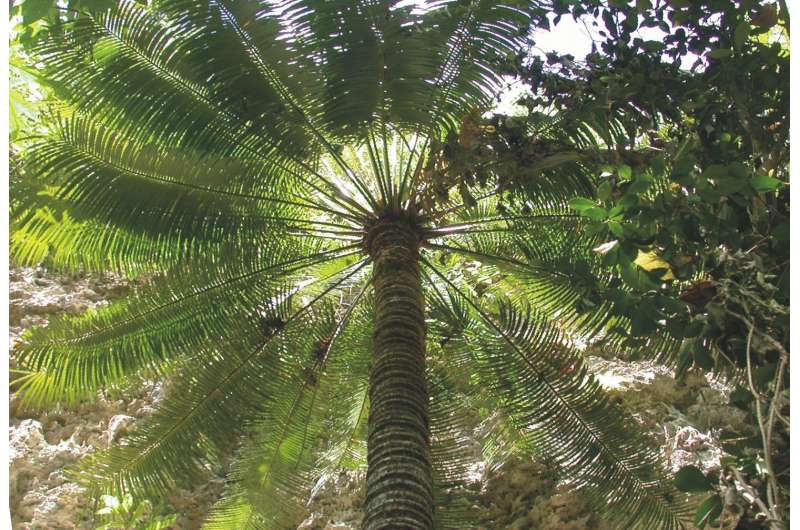Adventitious root formation on cycads saves trees, but informs new conservation dilemmas

Conservationists are often hindered by lack of knowledge to support decisions for conserving endangered plants. Applied research projects are often conducted in what scientists call an adaptive management approach. A recent adaptive management study from the University of Guam has revealed that large stem cuttings of the Endangered Cycas micronesica tree may be nurtured to produce adventitious roots which enable the creation of large transplants. The results appear in the current issue of the Journal of Threatened Taxa.
This tree is one of almost 350 described species of living cycads, a plant group that is highly threatened globally. The primary stems of cycads are equipped with the ability to produce adventitious buds, and the small lateral stems that grow from these buds are well-known for their ability to produce adventitious roots. For the Guam study, the tops of trees as tall as 4 meters were removed to determine if root formation could be encouraged on large cuttings from the apex of the main tree trunk. "This was an unprecedented opportunity to cut down large, mature trees for propagation purposes," said author Gil Cruz. "So the project was fun in that regard."
Successful root formation occurred on 41% of the cuttings in a nursery managed by experienced cycad horticulturists, but was unsuccessful in a nursery managed by silviculture specialists who lacked experience with cycad management. Large stem sections from healthy cycad trees would likely lead to 100% success. "But all of Guam's cycad trees are unhealthy due to years of damage by non-native insect pests, so the level of success could not be predicted without the results of this study," said author Thomas Marler.
Ongoing clearing of forested lands for construction activities on the island of Guam will be removing thousands of Cycas micronesica trees in the coming years. The results of this project indicate that the approach could be used to create large transplants without the need for expensive excavation of root systems, as occurs in traditional tree transplant protocols. However, just because nascent knowledge developed from adaptive management research reveals a new protocol, this does not robotically mean the protocol should be scaled up to widespread conservation implementation.
The authors discussed several dilemmas that emerge when large stem cuttings are used to create Cycas micronesica transplants. For example, the biotic threats that caused this tree to become endangered were initiated in 2003 when the first of several non-native insect pests invaded Guam, and these threats persist throughout Guam today. Salvage projects designed to rescue trees from construction sites do not address those primary threats. Therefore, trees transplanted in successful salvage projects may be destined to die along with the rest of the in situ population if these primary threats remain un-mitigated. Moreover, one of the most important environmental stresses of forest resources in the western Pacific is recurrence of tropical cyclones that topple many trees. Cycad trees that develop naturally by gaining size throughout the years following seed germination are equipped with root systems that resist toppling. But nothing is known about anchorage traits of the adventitious root system of this artificial type of transplant, or how the resulting trees will respond to the powerful storms. The first tropical cyclone following a large-scale transplant operation may topple the clonally propagated trees.
Provided by University of Guam



















